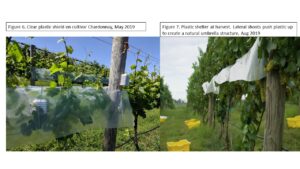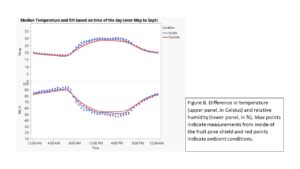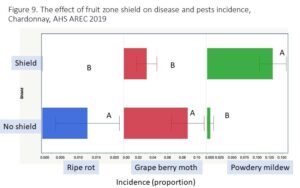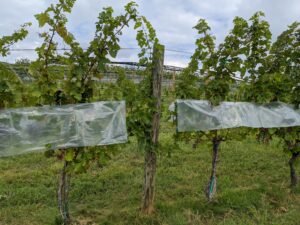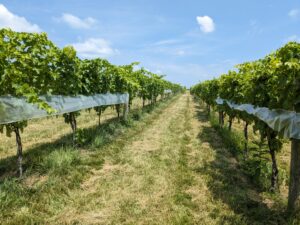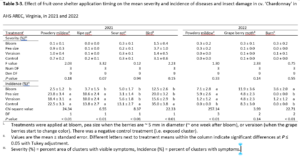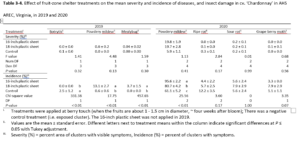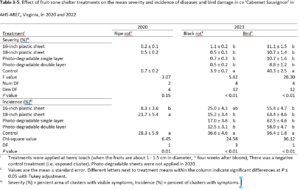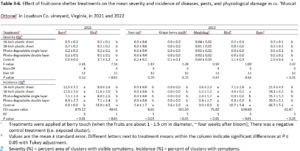Final report for OS21-144
Project Information
Encouraged by the results from bagging experiments, our lab has been experimenting with another type of protection using a sheet of plastic (Fig. 6). We placed a sheet of 4 Mil plastic (Uline Poly Sheeting S-5853) approximately 18 inches in length to cover the area between the first catch wire (typically placed approximately 18 inches above the fruiting zone) and the fruiting zone. We used a standard size staple (6.35 mm in length) and vineyard c-clips to secure the plastic on the wire. We did not have any frame structure to support the plastic; however, grapevines naturally produce lateral shoots. These shoots pushed up the plastic to create “umbrella” (Fig. 7). The plastic was placed in mid-May (soon after bloom). We tested the system with five-year-old Chardonnay grapevines and installed it on randomly assigned four panels. We placed two temperature and relative humidity sensors to monitor environmental conditions inside and outside of the plastic (Spectrum Technologies, Inc., model WatchDog A150 Temp/RH Logger)(Fig. 6). Diseases (Botrytis bunch rot, black rot, powdery mildew, ripe rot, and sour rot) were visually measured at harvest.
It took less than 30 min with three people to place these plastic sheets onto four panels of grapevines, including the time to experiment with staples and c-clips. This was considerably faster than bagging, which typically takes 2 min per 5 clusters (~ 48 min per panel of six vines, assuming 20 clusters per vine) based on our estimate. I.e., we were able to set up the shelter in less than 1/6 of the time required for bagging. Also this setup will be much more economical than building a permanent structure as in a high tunnel system [2].
Despite the very simple set up, these shelters lasted from May to October. We noticed small holes, most likely due to our activities, but all eight plastic sheets held together. As expected, the inside of the plastic cover tends to warmer than the outside, but the accumulation of humidity was less than I anticipated (Fig. 8). We also noticed that since the plastic can flap with winds, if we adjust our sprayer nozzles upwards from the underside of the fruiting zone, we were able to spray into the fruiting zone. From the 2019 trial, we found a significantly lower mean ripe rot and grape berry moth incidence with shelter clusters (Fig. 9). The only potential issue was powdery mildew, which prefers dry condition; however, in this trial, we placed the shelters before bloom spray, thus, we can probably prevent powdery mildew with proper fungicide sprays.
Objectives are: 1) Determine the efficacy of protective plastic (hereafter referred to as the fruit zone shelter) against the development of multiple fungal diseases on wine grape cluster; 2) Determine the timing of the fruit zone shelter application for optimal disease control; 3) Examine a photo-degradable material; 4) Examine two length of the shelter; and 5) Examine the effect of the fruit zone shelter to grape juice quality.
Vineyards and locations: Field experiments will be conducted at two locations 1) Experimental vineyard at AHS Jr. AREC, Virginia Tech, Winchester, VA (hereafter referred to as AHS AREC vineyard), and 2) Zephaniah Farm Vineyard, Leesburg, VA.
At AHS AREC, two commonly grown cultivars, Chardonnay, and Cabernet Sauvignon will be used [3]. Chardonnay was planted in 2013 and trained in spur-pruned (i.e. with cordons) vertical shoot positioning system (VSP). Cabernet Sauvignon was planted in 2014 and trained in cane-pruned VSP. Vine spacing within a row is 4 ft and between rows is 9 ft.
At AHS AREC vineyards, the experiment design will be a randomized complete block design with four blocks. Treatment will be applied to a panel, which contains six vines in between two posts. Fungicide application will be made every 7-10 days before bloom, then every 2 weeks using a low-volume air-blast sprayer (BDI Machinery, model p30). In order to challenge the system, we will aim for 10 applications per year. (Typical VA wine grape growers spray 14-20 times per year.)
AHS AREC Chardonnay vineyard. In this trial, treatment will be the timing of shelter application: 1) at 50% bloom, 2) at pea-size (~ 5mm in berry diameter), 3) at veraison, and 4) no shelter control. The fruit zone shelter will be applied as described in Figure 6. The fungicide program will be mainly protective materials (mancozeb, copper, and sulfur) with occasional use of a phosphorous acid for downy mildew, Quitec and Vivando for powdery mildew, and two applications against Botrytis to mimic a low-input management style.
AHS AREC Cabernet Sauvignon (organic) vineyard. We will examine an organic management approach by using OMRI-approved protective fungicides (copper, sulfur, polyoxin-D, and biological control agents e.g., Double Nickel [4]). The treatment will be 1) regular 4 Mil plastic sheet (18 inches in length), 2) 4 Mil plastic sheet (16 inches in length), 3) photo-degradable clear plastic mulch (1.25 Mil, 18 inches in length), 4) photo-degradable clear plastic mulch (1.25 Mil, 18 inches in length, double-layered to add weight), and 5) no shelter. The application of the treatment will be at pea-size.
Zephaniah Farm vineyard. We will use a section of a cultivar Cabernet franc for the experiment. The vines are trained in spur-pruned VSP, and the distance between vines are 6 ft and between rows are 10 ft. The treatments and experimental details will be the same as the AHS Chardonnay vineyard. Fungicide application will be conducted by the grower using their standard practice.
Data collection: We will examine the degree of spray penetration by placing water-sensitive papers on the inside and outside of the shelter. There will be four random locations tested inside and outside of the shelter, and examined after each treatment application. The water-sensitive paper will be stapled onto a leaf, and after application of fungicide, it will be brought to the lab, digitized with a camera (Nikon W300), and then the wet area will be estimated using graphic software Assess (ver. 1, APS, Minneapolis, MN). The environmental condition within the shelter and ambient conditions will be measured using temperature, relative humidity, leaf wetness, and photosynthetic active radiation (PAR) sensors. We will install two sets of remote sensors under the shelter per location, which connect via radio to a base weather station (RX3000, Onset comp.) which is already available at both locations. In addition, we will measure the amount of precipitation at ambient conditions.
At harvest, we will measure the level of diseases (black rot, Botrytis gray mold, powdery mildew, ripe rot, and sour rot) visually. Both disease incidence (yes or no) and severity (% area infected) per cluster will be measured. For each panel, we will collect 40 random clusters, i.e., 160 clusters per treatment.
At AHS AREC Cabernet Sauvignon and Zephaniah Cabernet franc vineyards, we will collect 100 berry samples from each treatment replications and submit for grape juice analysis to obtain soluble sugar content (Brix), pH, Titratable acid, Malic acid, yeast assimilable nitrogen, and total anthocyanin. The effect of the fruit zone shelter will be examined using the generalized linear model in JMP Pro (ver. 15, SAS Inc., Cary, NC). If the effect of the treatment is found to be significant, the Tukey-Kramer method will be used for the multiple comparisons of treatments.
Potential pitfalls and a backup plan: There will always be a chance of losing crops from external factors, such as spring frost events. Since we will have two locations and three vineyards we are hoping that each vineyard will serve as a backup so that we can obtain data.
Cooperators
- - Producer
Research
We conducted field experiments in a commercial vineyard in Loudoun Co. and a research vineyard at the Alson H. Smith Agricultural Research and Extension Center (AHS AREC), Winchester, VA. We refer to each location as Loudoun vineyard and AHS AREC vineyard. At AHS AREC vineyard, trials were conducted in two cultivar blocks, ‘Chardonnay’ (V. vinifera) from 2019 to 2022 and ‘Cabernet Sauvignon’ (V. vinifera) in 2020 and 2023. At Loudoun vineyard, trials were conducted in a ‘Muscat Ottonel’ (Vitis interspecific hybrid) block in 2021 and 2022. For each trial, the experimental design was a randomized complete block with four replications. In both locations, non-covered (exposed) vines were used as a control.
In addition to the shelters, we applied fungicides to control various diseases. At AHS AREC, the spray program was relatively soft approach (i.e., most likely less than a typical commercial grower would apply.) We sprayed Chardonnay blocks with mancozeb (Penncozeb or similar) and sulfur (Microthiol Disperss, both at 3.36 kg per ha) at 7- to 10-day intervals from bud break until mid-July and then copper (Cueva, Certis USA, at 9.35 L per ha) at 14-day intervals from late-July to harvest. We managed Cabernet Sauvignon blocks with copper (Cueva) throughout the season. At both cultivar blocks, the fungicide application during bloom was mixed with Rally (myclobutanil, Corteva USA) from 2019 to 2022 and Luna Experience (fluopyram and tebuconazole, Bayer Crop Science USA) in 2023. In the Loudoun vineyard, the collaborative grower applied mancozeb, sulfur, Rally, Rovral (iprodione, 2 pt per acre), and Delegate (spinetoram, 4 oz per acre, Corteva Agroscience USA) from bud break to pea size, while sulfur, Badge (copper hydroxide and copper oxychloride, 3 pt per acre, Isagro USA Inc.), Phostrol (mono- and dibasic sodium, potassium, and ammonium phosphites, 0.4% of spray water, Nufarm Americas Inc.), and captan (Captan 50W, 3 lb per acre, Drexel) were applied after pea size to post-harvest.
At both locations, we evaluated two materials: a 4 mil (0.1 mm) plastic (Uline Poly Sheeting S-5853 or HDX Poly Sheeting) and a 1.25 mil (0.03 mm) photo-degradable clear plastic sheet (Eco-One Oxo-degradable mulch, Robert Marvel Plastic Mulch, Annville, PA, USA). In addition, we tested 16-inch (40.6 cm) or 18-inch (45.7 cm) widths with the 4 mil plastic, and two layers (single and double) of the 1.25 mil photo-degradable clear plastic sheet (vertical width of 18-inch). At AHS AREC, we used Chardonnay block to examine the effect of shelter application timing in 2021 and 2022. We applied 18-in 4 mil plastic shelters were applied at either bloom, pea size (when the berries are ~ 5 mm in diameter), or veraison, and exposed fruit clusters served as a negative control.
At both locations, the bilateral vertical shoot positioning system (VSP), where shoots were guided upward from either a cordon or a cane was the vine training style. At about 35 cm and 80 cm, wires (catch wires) run parallel to the row. These wires wrap around the entire row, and by holding shoots between two wires, the shoots are trained upwards. We applied the plastic sheet to the area between two wire posts within the vineyard block (~ 7.6 m). We placed the sheets on the first catch wire to cover the fruiting zone on both sides of the canopy (i.e., we put two sheets per experimental unit). These sheets were secured on the wire using staples (6.0 mm in leg length, or 32/6 size, US standard), placed every 10 to 15 cm. Then we used vineyard c-clips (Finger Lakes Trellis Supply) placed every 30 cm or so to close the gap between the two first catch wires. This was to prevent rainwater from entering the fruiting zone through the gap between the two sheets. After the installation, the length of the shelter was approximately an inch shorter than the length of the sheet, and oftentimes, clusters were visible from the side of the canopy.
We visually assessed clusters within seven days of harvest. We recorded the incidence (presence/absence of cluster infection/damage) and severity (% area infected/damaged per cluster) of disease, insect/animal damage, bunch stem necrosis, berry shriveling, cracking, or splitting, and burn damage. We observed anthracnose (caused by Elsinoe ampelina), bitter rot (Greeneria uvicola), black rot Guignardia bidwellii), botrytis bunch rot (Botrytis cinerea), downy mildew (Plasmopara viticola), powdery mildew (Erysiphe necator), ripe rot (Colletotrichum spp.), sour rot (combinations of yeasts- Metschnikowia spp., Pichia spp., and Saccharomyces sp. and an acetic acid bacterium- Acetobacter spp. or Gluconobacter spp.), and sooty mold (various species of fungi, e.g. Scoias, Cladosporium, Fumago, and Capnodium). We also recorded feeding damage from grape berry moths and birds, numbers of mealybugs, and physical damage (skin burn-like symptoms). We used a rating scale ranging from 0 to 100, with increments of 5%. Since the dataset was obviously skewed at the time of assessment, we assessed the normality for each dataset. Based on the results, where none of the dataset was normally distributed, we selected non-parametric statistics, Wilcoxon–Mann–Whitney test, to evaluate the treatment effect (NPAR1WAY procedure, SAS ver. 9.4, SAS Institute, Cary, NC). For the mean separation, we used the Kruskal-Wallis test.
Application timing: AHS AREC Chardonnay 2021-22
The efficacy of an 18-inch fruit-zone shelter applied at different developmental stages was evaluated to determine the optimal timing for shelter application. We found that the shelter application at bloom resulted in a significantly lower mean incidence of powdery mildew and ripe rot in 2021 (P ≤ 0.05). Additionally, all application timings showed a significantly lower mean incidence of sour rot and bird damage than the control treatment during 2021. The fruit-zone shelter likely prevented rain and birds from the fruits, acting as a physical barrier. The earlier (at bloom) application worked better with ripe rot since flower parts are susceptible to ripe rot pathogen infection. On the other hand, the reduced sour rot incidence was observed regardless of the application timing. Since sour rot develops after veraison (i.e., after our last application timing), these results match the previous research results.
On the other hand, although numerically lower than in 2021, powdery mildew under the shelter, regardless of the timing, occurred at a significantly higher mean incidence than in the exposed control. The increase in powdery mildew is most likely due to poor viticultural practices. I.e., in order to prevent powdery mildew, one must do a thorough canopy management and fruit zone fungicide spray before applying the fruit zone shelter.
Chardonnay (shelter length), 2019 – 2020: The 18-inch plastic sheet significantly reduced the incidence of Botrytis bunch rot compared to the control treatment in 2019. Over the two years, powdery mildew was consistently observed, with a significantly (P ≤ 0.05) higher incidence with the 18-inch shelter in 2020, where it ranged from 61% to 96% among treatments and control (Table 3-4). The exposed control treatment exhibited a significantly lower incidence of powdery mildew in 2019 and 2020 than other treatments (P ≤ 0.05). Similarly, the mean mealybug count was significantly higher with the 18-inch plastic sheet treatment. Ripe rot, sour rot, and damage from grape berry moth were rated in 2020, but differences between treatment and control were not statistically significant (P > 0.05).
Cabernet Sauvignon (organic), 2020 – 2023: The 16-inch sheet treatment had a significantly lower mean ripe rot incidence than other treatments, with treatment mean incidence rates varying from 8 to 28% (Table 3-5). In 2023, we observed that the shelter treatments had significantly (P ≤ 0.05) lower severity and incidences of black rot and bird damage than the control. The mean bird damage severity ranged from 9 to 11% under shelters, compared to 40% for exposed clusters, which shows the effectiveness of shelter from birds.
Loudoun vineyard, 2021 – 2022: In 2022, the mean incidence of both sour rot and grape berry moth damage under the protection, regardless of the type and length, was significantly lower than that of the exposed control (P ≤ 0.05) (Table 3-6). In both years, photo-degradable plastic provided significantly better protection against bird damage than the exposed control. However, the protective shields resulted in a significantly higher mean incidence of burn (i.e., heat damage on berry skin) than the exposed control in 2021, and there were significantly more mealybugs found under the protection in 2022, which is consistent with the AREC 2019 data.
Discussion
This study examines the efficacy of fruit-zone shelters in mitigating various grape diseases and disorders. We examined two types of materials, two lengths to cover the fruit zone, three application timings, and two fungicide regimens (conventional and organic) among three different vineyards over five years. Our findings support that fruit-zone shelters, by shielding grape clusters from rainwater, can significantly reduce the incidence of black rot, Botrytis, and sour rot. In some cases, the level of ripe rot was also lower under the protection. This aligns with the findings of Du et al. (2015) and Ahn et al. (2012), who reported the efficacy of controlling ripe rot and Botrytis bunch rot.
Rain shelters have shown effectiveness in reducing downy mildew in grapevines (Yu et al. 2017), scab, and rust in pears (Lim et al. 2014), Botrytis fruit rot in strawberries and raspberry (Xiao et al. 2001; Comeau et al. 2012), strawberry mildew (Sphaerotheca macularis) in strawberry (Claire et al. 2018). Kim (2001) also reported a lower incidence of disease, rust, anthracnose, powdery mildew, and root rot in peonies under rain shelter cultivation compared to open-field conditions. Prolonged wetness significantly increases the risk of outbreaks of diseases such as downy mildew, white rot (Coniella diplodiella), and ripe rot (Lalancette 1988; Brook 1992; Vercesi et al. 2000; Estrada et al. 2000; Longland and Sutton 2008). By altering the microclimate within the grape canopy, rain shelters create conditions unfavorable for these pathogens. The other studies highlight rain shelters' role in preventing spore dispersal (Comeau et al. 2012; Du et al. 2015).
We also found the mean incidence of sour rot and bird damage was significantly reduced in some years and locations. Sour rot's emergence is contingent upon the presence of yeast, acetic acid bacteria, and Drosophila fruit flies (Hall et al. 2018). The lack of open wounds, from lower grape berry moth and bird damage, might have lowered the risk of sour rot pathogens and pests thriving. The reduction in sour rot incidence may also be due to impeding fruit fly access, or the overall dry condition might not be ideal for disease development; however, further verification is necessary.
Conversely, we observed an upsurge in powdery mildew under sheltered conditions, paralleling previous studies (Fei et al. 2011; Du et al. 2015). This disease thrives in environments with low light intensity and moderate temperatures (20–28 °C) with high relative humidity (80~90%) (Xiao et al. 2001; Boso et al. 2018) that suggests rain shelters may create favorable conditions for powdery mildew. Xiao et al. (2007) found that powdery mildew on strawberries was higher in tunnels than in the field. Since the level of powdery mildew did not differ among the timing of shelter applications, these shelters might be better applied after a critical period of powdery mildew berry infection (Gadoury et al. 2003).
According to Tracey and Saunders (2003), bird damage can cost a single vineyard up to 83 percent of its yield. Bird damage to wine grapes was estimated by growers from Michigan, New York, Oregon, California, and Washington to be between 2.9 and 9.2 % in 2011, and bird damage to blueberries was reported to be between 3.8 and 18.2 % (Anderson et al. 2013). Our study showed that the mean incidence or severity of bird damage was significantly lower under the shelter in four out of eight trials. The reduction range was 34 to 100%.
We observed a significantly higher mean mealybug incidence count in two years during our study. In a study of mealybugs in Brazil, sun, rain, entomopathogenic fungi, and general predators negatively impacted the mealybug population (Rodrigues-Silva et al. 2017). Thus, the protection from outside elements and predators might have favored mealybug populations. On the other hand, Moreau et al. (2022) reported varied effects ranging from positive to neutral or negative; thus, the broader impact of rain shelters on canopy insects remains a subject of ongoing investigation.
We also observed burn damage in fruit clusters protected by fruit-zone shelters, likely due to the tissue underneath being heated up and the plastic preventing the normal cooling process in sunlight. This aligns with the findings of Fei et al. (2011) that rain-shelter cultivation increases canopy temperature, a phenomenon also noted in North American high and low tunnel structures (Claire et al. 2018).
This study explored the possibility of protective material without expensive structures to achieve similar goals. One roll of clear poly sheeting of 0.1 mm, 1.8 m x 30.5 m in size, costs $24 (uline.com), and one roll of 0.03 mm photodegradable clear plastic sheet, 1.2 m x 2,793.2 m in size, costs $387 (glaciervalleyenterprise.com). We cut them into two pieces to fit our intended width for the shelter cover. In a typical vineyard in Virginia (with 10 ft row-spacing and 5 ft vine-spacing), there are 871 vines in a one-acre vineyard (https://www.vinetechcanada.com/help-tips/vines-per-acre/ ). Then the total area we needed to cover, including both sides of the vine, is 871 vines x 5 ft x 2 sides = 8,710 ft or 2,655 m; thus, a roll of the photo-degradable plastic mulch can cover an acre. Therefore, using photodegradable clear plastic sheets can be a great alternative to a commercial single-bay high tunnel, which is very expensive.
In conclusion, this study substantiates the efficacy of fruit-zone shelters in controlling grapevine diseases, offering a potential non-chemical alternative for disease and pest management. The shelters are known to contribute to the reduction in fungicide use and enhancement of grape yield and quality, thereby positively influencing market prices and growers' income (Du et al. 2015). Claire et al. (2018) reported that the higher marketable yields of strawberries under rain shelters substantially offset the initial investment costs. Thus, the strategic implementation of rain shelters presents a promising avenue for sustainable and economically viable disease and pest management in grape cultivation.
Educational & Outreach Activities
Participation summary:
We held one field day at Zephaniah Farm Vineyards to demonstrate the effect of the protective shelters on table grape quality. At this event, participants (~100 people) were winery customers. We had a video on the protection tools and a tasting event to compare treatments. In addition, some of the results were presented at three outreach events and four extension meetings.
- Nita, M (2023) Effect of fruit shelters on table grapes, VCE Field Day, Leesburg, VA, 08/25/2023, Oral
- Nita, M (2023) Overview of Grape Pathology Program, AHS AREC Open House, Winchester, VA, 08/19/2023, Oral
- Nita, M (2023) Updates from the Grape Pathology Program at Virginia Tech, Virginia Vineyards Association Summer Technical Meeting, Charlottesville, VA, 06/19/2023, Oral
- Nita, M (2023) Downy mildew and black rot management reminder plus Research updates: Grape Path, Plant Disease Clinic, Sentinel Vineyards, and Cultivar Trial, Virginia Vineyards Association Winter Technical Meeting, Charlottesville, VA, 02/16/2023, Oral
- Nita, M (2023) Fungicide Field Trials with “alternative” materials: grape late season rots and protective materials, Winchester, VA 2020 - 2022, Eastern Viticulture and Enology Forum, Online, 02/07/2023, Oral
- Nita, M (2022) Grape Pathology Field Trials 2022, AHS AREC Field Day, Winchester, VA, 09/16/2022, Oral
- Nita, M (2022) Phomopsis and Ripe rot (and sour rot) management, Eastern Viticulture Webinar series, Sharpen your spray program, Online, 03/28/2022, Workshop
- Nita, M (2021) Grape Pathology Program, AHS AREC Open House, Winchester, VA, 08/14/2021, Oral
Learning Outcomes
Reduction in the level of grape diseases, especially late-season rots.
Reduction in bird damage.
Reduction in grape berry moth damage
Potential reduction in fungicide and insecticide uses
Potential increase of powdery mildew and mealybugs and associated practices to mitigate these issues.
Project Outcomes
This study demonstrated the effectiveness of fruit zone shelters against various grape diseases, insect pests, and some physical damages. The positive effect was observed in both conventional and organic vineyards. While conducting the experiment, one commercial grower who wished to reduce their fungicide application adopted the practice and reported great success with managing key diseases. Another grower adopted a similar technology in 2024.
We need more studies to investigate the cost-effectiveness of the practice; however, the cost of application most likely outweighs the cost of fungicide application, given the increased labor cost and potential loss of key fungicides such as captan and Ziram in the future. This will also contribute to the future sustainability in both economic and environmental benefits for growers. Socially, we ran a simple survey with a similar protective structure (not covered by this grant) where we asked participants whether they liked the idea and were willing to pay more for fruits. Among 50+ people who answered the survey, more than 70% indicated that they would pay more if the fruits were grown with less pesticide application.
